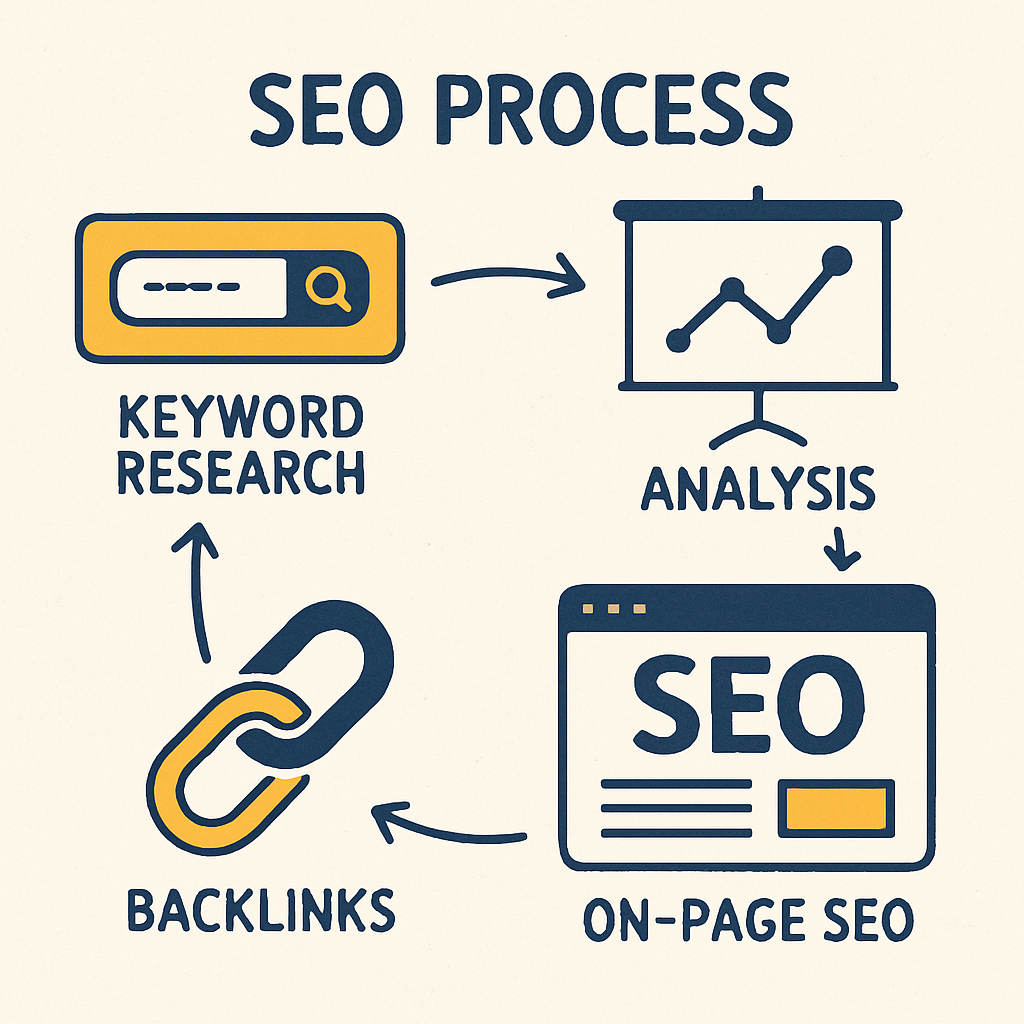Introduction to SEO
Imagine you own a fantastic coffee shop, but it’s hidden away on a side street with no signs. How would customers find you? In the digital world, your website is that coffee shop, and search engines like Google are the maps people use to find things. Search Engine Optimization, or SEO, is the practice of putting up bright, clear signs that guide search engines—and potential customers—directly to your digital doorstep. It’s the process of making your website more visible on search engine results pages (SERPs) for relevant queries.
This article will break down exactly what SEO is, explore its essential components, and explain why it is a critical strategy for any business or individual looking to grow their online presence. We will demystify the core concepts, from the content on your pages to the technical aspects behind the scenes, giving you a solid understanding of how SEO works to attract valuable, organic traffic.
Key Components of SEO
SEO is not a single activity but a collection of strategies that work together to improve your search engine rankings. These strategies are often grouped into several key categories. Understanding each one helps you build a comprehensive and effective SEO plan.
On-Page SEO
On-page SEO involves optimizing the elements directly on your website to improve your rankings. This is where you tell search engines what your content is about. These optimizations make your site more user-friendly and easier for search engine crawlers to understand.
Keyword Research and Integration
This is the foundation of on-page SEO. It involves identifying the words and phrases your target audience uses when searching for products, services, or information related to your business. Once you know these keywords, you can strategically integrate them into your website’s content, headings, and meta tags
High-Quality Content
Content is the heart of SEO. Search engines aim to provide users with the most relevant and helpful results. Creating high-quality, original, and in-depth content that answers user questions is crucial. This includes blog posts, articles, videos, and product pages that are informative and engaging.
Title Tags and Meta Descriptions
Your title tag is the clickable headline that appears in search results, while the meta description is the short summary underneath it. Both should include your primary keyword and be written to entice users to click on your link over a competitor’s. They are your first opportunity to make an impression on the SERP.
Header Tags and Structure
Using header tags (H1, H2, H3, etc.) correctly organizes your content for both readers and search engines. Your H1 is your main page title. H2s and H3s create a logical hierarchy, breaking up text and making it easier to scan. This structure helps search engines understand the main topics and subtopics of your page.
Internal Linking
Internal linking is the practice of adding links from one page on your website to another. This helps search engines discover new pages, understand the relationship between different pieces of content, and spread link authority throughout your site. It also keeps users on your site longer by guiding them to related information.
Off-Page SEO
Off-page SEO refers to actions taken outside of your own website to impact your rankings within search engine results pages. These factors help build your website’s authority and reputation, signaling to search engines that your content is valuable and trustworthy.
Backlinks
Backlinks are links from other websites to yours. They are one of the most important ranking factors. A backlink from a reputable, high-authority site acts like a vote of confidence, telling search engines that others vouch for your content. Building a strong backlink profile is a central part of off-page SEO.
Link Building Strategies
Link building involves actively acquiring backlinks. This can be done through creating shareable content that others want to link to, guest blogging on other sites, or reaching out to webmasters to request links to your relevant content.
Brand Mentions and Social Signals
Search engines also look at how your brand is mentioned across the web. Mentions of your brand name, even without a link, can contribute to your authority. Similarly, shares, likes, and comments on social media platforms can signal that your content is popular and engaging, which may indirectly influence rankings.
Technical SEO
Technical SEO focuses on optimizing the backend of your website to ensure search engine crawlers can efficiently index your site. A technically sound website provides a good user experience and a solid foundation for all your other SEO efforts.
Website Speed
Page load speed is a critical ranking factor. Users expect pages to load quickly, and search engines prioritize sites that deliver a fast experience. Optimizing images, leveraging browser caching, and minimizing code can all help improve your site speed.
Mobile-Friendliness
More searches are now conducted on mobile devices than on desktops. Because of this, Google uses mobile-first indexing, meaning it primarily looks at the mobile version of your site for ranking. A responsive design that adapts to all screen sizes is essential.
Site Architecture and Crawlability
Your website’s structure should be logical and easy for search engine bots to crawl. A clear XML sitemap helps crawlers find all your important pages, while a clean URL structure makes it easy to understand what each page is about.
Security (HTTPS)
Having a secure website (using HTTPS instead of HTTP) is a confirmed, albeit small, ranking signal. It encrypts data between a user’s browser and your server, protecting sensitive information and building trust with visitors.
Local SEO
For businesses that serve a specific geographic area, local SEO is vital. It involves optimizing your online presence to attract more customers from relevant local searches.
Google Business Profile
Your Google Business Profile is a free tool that allows you to manage how your business appears on Google Search and Maps. Optimizing your profile with accurate information, photos, and customer reviews is crucial for local visibility.
Local Keywords
Incorporating location-specific keywords (e.g., “plumber in Brooklyn”) into your website content helps you rank for local searches.
Citations and Reviews
Citations are mentions of your business’s name, address, and phone number (NAP) on other websites, like online directories. Consistent NAP information across the web builds trust. Positive customer reviews also significantly impact local rankings
Why is SEO Important?
Investing time and resources into a solid SEO strategy offers significant returns for almost any business. It goes beyond simply ranking higher; it drives tangible business results.
Attracts High-Quality Traffic
SEO helps you connect with users who are actively searching for the solutions you provide. This intent-based traffic is often more valuable than traffic from other channels because the user is already looking for what you have to offer.
Builds Trust and Credibility
Users trust search engines. Seeing your website at the top of the search results for relevant queries builds instant credibility. It signals that you are an authority in your field, which can lead to higher trust and better conversion rates.
Provides Long-Term Value
Unlike paid advertising, which stops as soon as you stop paying, SEO provides lasting results. A page that ranks well can continue to bring in organic traffic for months or even years. While SEO requires ongoing maintenance, the foundational work you do can deliver long-term, sustainable growth.
Offers a Better User Experience
Many SEO best practices, such as fast load times, mobile-friendliness, and easy navigation, are directly tied to providing a better user experience. A website that is easy and pleasant to use will not only rank better but also engage and convert visitors more effectively.
It’s a Cost-Effective Marketing Strategy
While it requires an investment of time and resources, SEO is one of the most cost-effective marketing strategies. Organic traffic is free, and a successful SEO campaign can deliver a higher return on investment than many forms of paid media. By focusing on SEO, you are building a valuable asset that will continue to generate leads and sales over time



